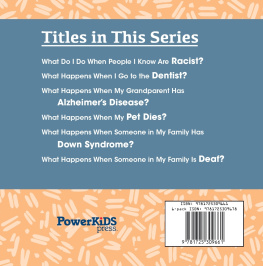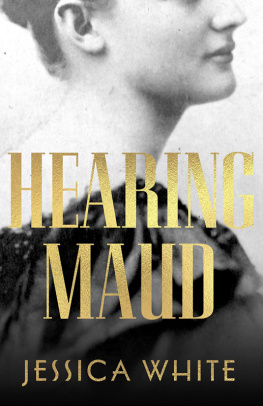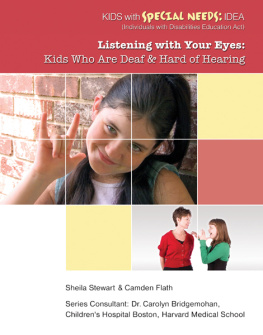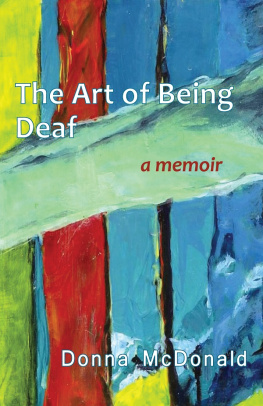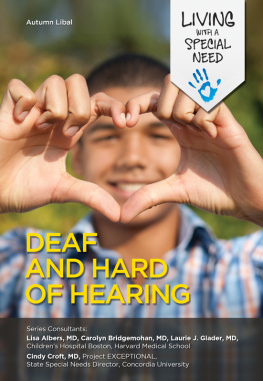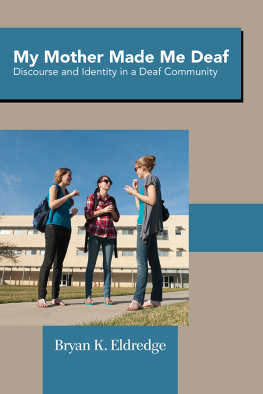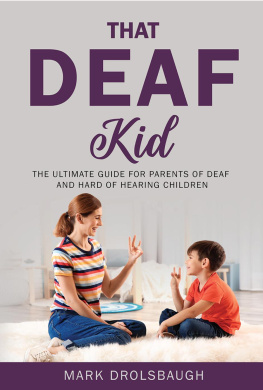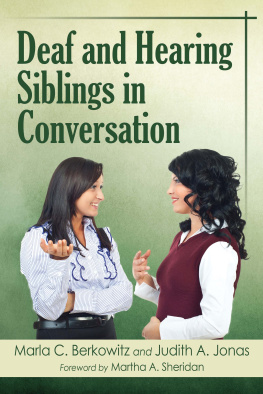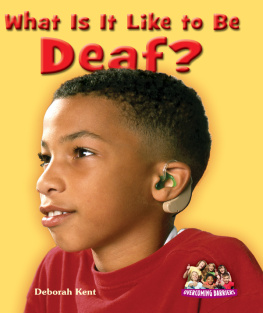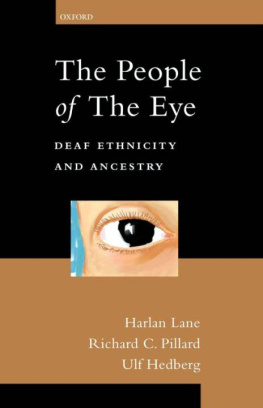Writing Deafness
2007 The University of North Carolina Press
All rights reserved
Set in Minion type by Keystone Typesetting, Inc.
Manufactured in the United States of America
The paper in this book meets the guidelines for permanence and durability of the Committee on Production Guidelines for Book Longevity of the Council on Library Resources.
Library of Congress Cataloging-in-Publication Data
Krentz, Christopher.
Writing deafness : the hearing line in nineteenth-century American
literature / Christopher Krentz.
p. cm.
Includes bibliographical references and index.
ISBN 978-0-8078-3118-2 (cloth: alk. paper)
ISBN 978-0-8078-5810-3 (pbk.: alk. paper)
1. DeafUnited StatesHistory19th century. 2. Deaf, Writings of the, American. 3. Deaf authors. 4. American literature19th centuryHistory and criticism. I. Title.
HV2545.K74 2007
810.9'3527209034dc22 2006039794
Portions of this work appeared earlier, in somewhat different form, in Exploring the Hearing Line: Deafness, Laughter, and Mark Twain, in Disability Studies: Enabling the Humanities, ed. Sharon L. Snyder, Brenda Jo Brueggemann, and Rosemarie Garland-Thomson (New York: Modern Language Association, 2002), and in A Mighty Change: An Anthology of Deaf American Writing 18161864 (Washington, D.C.: Gallaudet University Press, 2000). Reprinted here with permission of the publishers.
cloth 11 10 09 08 07 5 4 3 2 1
paper 11 10 09 08 07 5 4 3 2 1
For my parents
Contents
1. I Write What You Speak:
Writing and the Emergence of the American Deaf Community, 18161835
2. Essaying the Unsayable:
The Deaf Presence in Antebellum American Literature
3. Powers of Deafness:
Deaf Characters by Hearing Authors
4. A Sense of Two-ness:
Deaf Double Consciousness at Midcentury
5. Playing with the Hearing Line:
Deafness, Passing, and Laughter
Illustrations
Laurent Clerc
The first home of the American Asylum, 1817
Thomas Hopkins Gallaudet
Ichabod flees the Headless Horseman
Hawk-eye gestures to Chingachgook
Lydia Huntley Sigourney
John Carlin
The National Deaf-Mute College class of 1870
Laura Redden Searing
An articulation class
Mark Twain with Helen Keller
The king and duke mourn their dead brother
Students at Gallaudet College, 1896
Acknowledgments
Writing Deafness has roots in my personal experience. I am late deafened; my hearing has gradually faded since I was nine years old. As I was growing up, literature provided me with a welcoming place. While spoken conversation was sometimes difficult for me to follow, and films and television programs typically were not captioned, reading offered a way for me easily to comprehend what was being said (on a literal level, anyway). After college, I found my way to the deaf community and began to learn American Sign Language, interact with deaf signers, and proudly identify myself as deaf. When I went to graduate school at the University of Virginia and reread classic works of American literature, I found I experienced them in a new way.
Many friends, teachers, and institutions have shaped this book, and it is a pleasure to thank them even if I cannot acknowledge them all here by name. This project started as my dissertation. Eric Lott and Stephen Railton believed in it from the very beginning and offered invaluable encouragement, guidance, and insight as it gradually took shape. When I began writing, I was part of a group lobbying for the establishment of an American Sign Language (ASL) program, and that spirit of activism probably animates these pages. Ellen Contini-Morava, Lisa J. Berke, and John Bonvillian made especially good co-agitators in the cause, as did a lively cadre of deaf and hearing students.
I am indebted to Michael Olson and Ulf Hedberg at the Gallaudet University Archives and to David Halberg and Winfield McChord Jr. at the American School for the Deaf for their affable and essential assistance. They not only enabled me to find the information I was seeking, but also told good stories along the way. The library staffs at Yale, Harvard, the University of Virginia, the University of Chicago, the American Antiquarian Society, and the Portsmouth Athenum helped me to locate additional archival materials.
A portion of chapter 5 appeared in Sharon L. Snyder, Brenda Jo Brueggemann, and Rosemarie Garland-Thomson, eds., Disability Studies: Enabling the Humanities (Modern Language Association, 2002). Very early versions of segments of chapters 1 and 4 were published in my anthology, A Mighty Change: An Anthology of Deaf American Writing 18161864 (Gallaudet University Press, 2000). Thanks are due to the publishers for permission to reprint this material and to Rosemarie Garland-Thomson and John Vickrey Van Cleve for their editorial guidance.
A number of people generously read the entire manuscript or individual chapters and offered helpful suggestions and advice: Stephen Arata, Alison Booth, Arlene Clift-Pellow, Stephen Cushman, Jessica Feldman, Rita Felski, Susan Fraiman, Jahan Ramazani, Lisa Woolfork, and especially Douglas Baynton, Brenda Jo Brueggemann, Ellen Contini-Morava, and Lennard J. Davis. Their comments have greatly improved the book, although I know I have not answered all their penetrating questions. Jennifer Wicke was a generous source of advice, and Eric Schramm helped to prepare the manuscript. Sian Hunter and Ron Maner at the University of North Carolina Press provided immense support in bringing the book to completion. I am also grateful to the University of Virginia for a Sesquicentennial Associateship and small grants that enabled me to focus on writing.
This study also would not have been possible without Gallaudet University, the worlds premier college for deaf people. Inspired by the 1988 Deaf President Now movement and the schools charismatic deaf president, I. King Jordan, at age twenty-three I sought a staff position there. During four wonderful years at Gallaudet, I discovered how rich deaf experience can be. Jean Lindquist Bergey initially made me feel welcome. Stephen Ryan, Lorraine Flores, and Angela Farrand were my first ASL teachers, serving as models of patience and encouragement as I tried to learn a radically new language. Bernard Bragg, Clayton Valli, and Gilbert Eastman introduced me to the grace and beauty of ASL poetry and storytelling, while Jack Gannon and Vic Van Cleve interested me in deaf history. Mary Anne Pugin traveled with me to visit alumni chapters in thirty-three states and Canada, giving me a fun and fascinating tour of deaf America. Lynda Carter, Kubby Rashid, and Anne Marie Baer also taught me much and remain good friends.
Others have kept me going along the way. My students at the University of Virginia have helped me to develop my ideas, as have the gifted and witty instructors in the U.Va. ASL program. Greg Propp, sign language interpreter par excellence, has added to my joy in teaching. Ben Bahan, Dirksen Bauman, Carol Padden, Kristen Harmon, and others in the small field of Deaf Studies have offered indispensable encouragement. The Disability Studies in the Humanities and Deaf Academics e-mail discussion lists have given me supportive communities of scholars who are interested in similar topics; my work would have been far more challenging without them. My college roommates Patrick Clyde, John Comeau, Elbert Ocaas, and Andrew Silbiger kept me laughing with their messages from afar. Friends in my deaf game night group and at Charlottesville signing suppers have provided many fun get-togethers, while I have gained happiness and companionship from the women I have been lucky enough to date.
Finally, I wish to thank my family. My siblings Peter, Michael, Elizabeth, Susie, and Matthew have, each in their own way, added much to my life and kept me both confident and humble. I cannot begin to say what I owe my parents, Edgar and Marion Krentz, to whom this book is lovingly dedicated.


